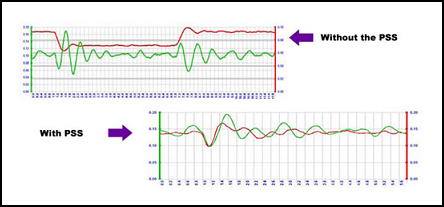
INTRODUCTION
Power System Stabilization (PSS) is a device that enhances the damping of low frequency oscillations at the synchronous machine by controlling excitation. As a benefit of the action of several PSSs at several synchronous machines, the stability of the whole power system increases. As per IEGC, installation of PSS and its periodic tuning is mandatory. Importance of a tuned PSS increases during Grid disturbances. PSS Tuning now being monitored by RPCs. Further, it has been generally observed that our 500MW Units having BHEL machines with brushless excitation system & DVR are not producing enough or appreciable damping through PSS action when step test is carried out.
DEMONSTRATION PROJECT
i) In NTPC, PSS tuning is normally carried out with the help of OEM by taking the response through step test. However, optimum response is not possible to achieve by this approach and thus PSS response verification test is only carried and it cannot be considered as optimum.
-Attainable touch potential < Tolerable touch potential
ii) In practice, effective optimization of PSS response is a complex process and not possible without modelling studies & computer simulation. Values of various Gain settings / parameters of AVR & PSS derived through simulation studies are adopted in actual system. Actual System Response or oscillations are then analysed and further simulation studies are carried out to arrive at the optimum setting / gains.
iii) The study was carried out to perform optimum tuning of the Power System Stabilizer operating at 490 MW, 21 KV, 50 Hz synchronous generator in NCTPP ST-II DADRI (unit no 6). The outcome of the analysis was expected to be the optimum PSS parameters settings together with expected performance presentation. Finally proposed settings was to be adopted in the AVR and measurements to be performed to verify simulations. Dynamic performance of the AVRs with PSS for the analyzed generator set was validated using dynamic modelling and time domain simulation. PSS settings were elaborated based on frequency responses of linearized model, taking into account generic rules for PSS tuning. Performance of the AVR with PSS was verified by means of eigenvalue calculations and time domain simulations. DIGSILENT Power Factory software was used in the study.

